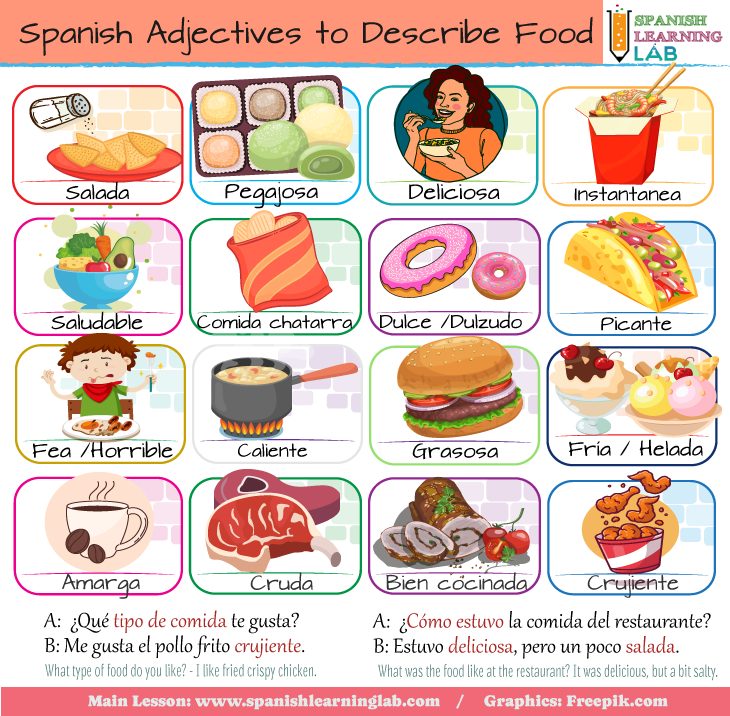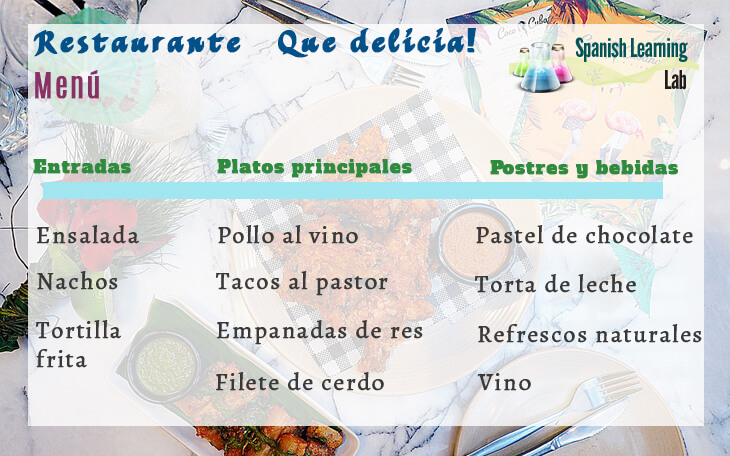¡Hola! Today’s lesson aims at helping you learn the vocabulary, phrases and questions that you need to order your favorite food at a restaurant in Spanish. We have included many examples about food descriptions, ways to ask the waiter for the specialties of the house, ways to make reservations and more. In addition, this lesson will introduce the names of some popular Latin American dishes in Spanish. Let’s start…
Common questions and phrases at the restaurant in Spanish
When you are in the restaurant, the first words you will need are greetings and farewells like “Hola” and “Mucho gusto”. Besides some greetings, you will need many other expressions, which will be presented next in three different sections:
Describing food and a restaurant’s menu in Spanish
First, it is very important to use the right adjectives to describe food, that is words such as “Delicioso”, “Sabroso” (delicious), “Feo” (not delicious in this case), “picante” (spicy), “dulce”(sweet) and “salado” (salty), among many others. Sentences describing food in Spanish will make use of the verbs SER and ESTAR, e.g. “El filete está delicioso” and “La comida es sabrosa en ese lugar”. Some essential nouns to have a conversation at a restaurant are: “mesa” (table), “reservación”, “comida”(food), “plato principal” (main dish), “entrada” (appetizer) and “postre” (dessert). The picture below shows a list of essential adjectives we use very often to describe food in Spanish:

Sometimes, restaurants will have their menu (El menú) in both English and Spanish, which offers learners a great opportunity to practice this topic in a more realistic context. As with all menus, they include prices (precios), a few or many dishes, and of course some special offers. Next, we show you a very simple menu with the names of some dishes in Spanish:

Common questions that customers ask at the restaurant in Spanish
As customers, we may come up with lots of different questions to ask the waiter or any other person at the restaurant, especially if we are there for the first time. Listen to some of the most common things that customers ask and the possible answers for these questions:
| Buenos días. Una mesa para dos (personas) por favor. Good Morning. A table for two (people) please. |
|
Buenas noches. ¿Me puede mostrar el menú por favor?
Good night!. Can you show me the menu please?
|
|
Aló, llamo para reservar una mesa para cuatro.
Hello? I’m calling to book a table for four.
|
|
¿Cuál es la especialidad de la casa?
What is the restaurant’s specialty?
|
|
¿Qué nos puede recomendar?
What do you recommend me?
|
|
¿Qué trae este platillo?
What does this dish include?
|
| ¿Hay algún combo disponible? Is there any combo available? |
| Ordenaré/Pediré este plato. I will order this dish. |
|
¿Qué bebidas tiene?
What drinks do you have?
|
| ¿Me puede traer la cuenta por favor? Can you get me the bill please? |
Things that waiters say at the restaurant in Spanish
On the other hand, the waiter (el mesero) or the waitress (la mesera) will usually welcome you with a greeting like “Bienvenido, pase adelante por favor” (welcome, please come in) or “Bienvenido, ¿Tiene reservación?. Once you are inside the restaurant, the waiter could say or ask any of these things:
|
Por favor tome asiento.
Please take a seat.
|
|
Permítame llevarlo a su mesa.
Let me walk you to your table
|
|
Aquí tiene el menú
Here is the menu
|
|
¿Desea ordenar? /¿Qué le gustaría ordenar?
Would you like to order?
|
|
¿Qué le gustaría tomar?
What would you like to drink?
|
|
Le recomiendo probar el filete de cerdo a la plancha.
I recommend you to try the grilled pork steak.
|
| El combo número tres lleva/trae arroz, papas fritas, ensalada y 8 piezas de pollo. Combo number three includes rice, chips, salad and 8 pieces of chicken. |
|
¡Buen provecho!
Enjoy!
|
|
Aquí tiene la cuenta.
Here is the bill.
|
There are many typical dishes in Latin America. Sometimes these dishes have the same name across countries, but the recipe is totally different. Mexican food is probably the most famous Latin food in the US, although there are so many great dishes in the rest of the continent. “Pupusas” for instance are representative of “El Salvador”, “Nacatamales” and “El Gallo pinto” are traditional dishes in Nicaragua, and just the same “Bandeja Paisa” is a very important one in Colombia.
Listening Activity No.1: Common Latin food in Spanish – La comida latina
Listening Activity No.2: At the restaurant in Spanish – En el restaurante
Key phrases in the conversation:
- “Pasen por aquí por favor” means “Come this way please!”
- “Me gustaría comer de todo” means “I’d like to try everything”
- “Voy a pedir/ordenar” means “I will order…”
You have made it to the end of this lesson. When you master the key expressions and questions in this lesson, try to find a Latino restaurant nearby and order something to eat in Spanish. Have fun and ¡Buen provecho!
Related Spanish Worksheets:
- Fruits and vegetables in Spanish – PDF Worksheet
- Food in Spanish: conversation cards – PDF worksheet
- The Vocabulary for Food and Drinks in Spanish
- At a Fast Food Restaurant in Spanish – PDF Worksheet
- Food and Drinks in Spanish –Crossword Puzzle
- Fruits and Vegetables in Spanish – PDF Crossword Puzzle
- Cooking Verbs in Spanish (Labeling vocabulary)
